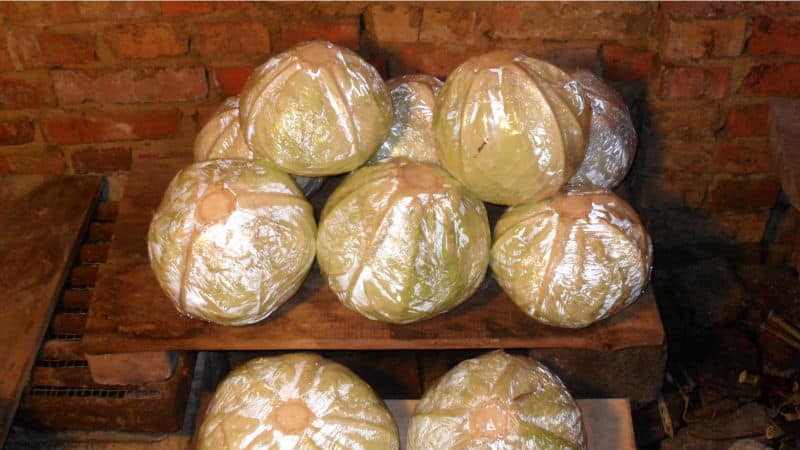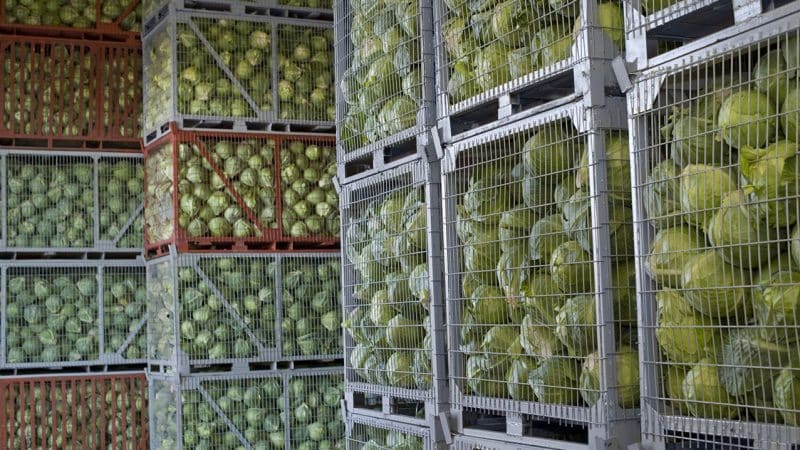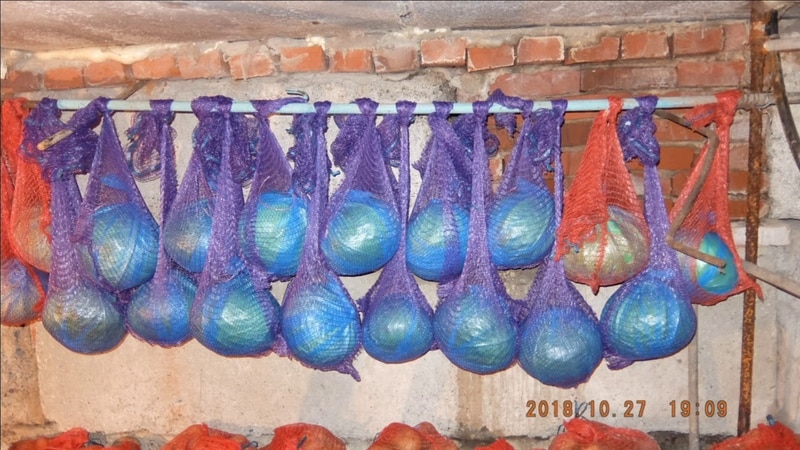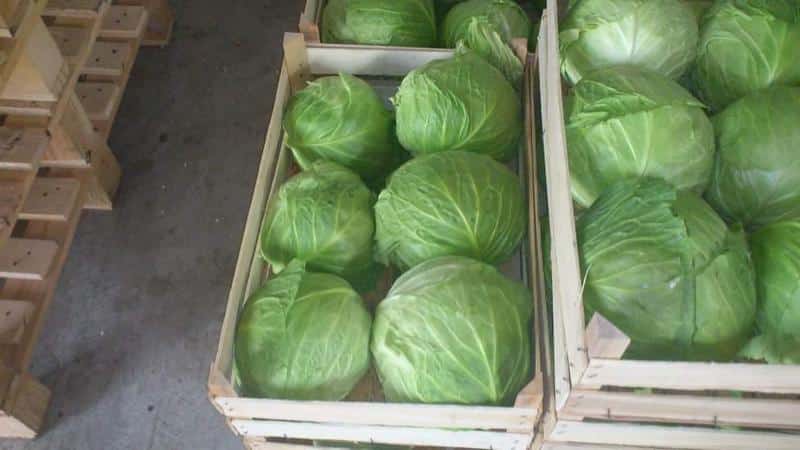The best ways to store cabbage in the cellar in winter
Basement and cellar are suitable places for storing vegetables. Experienced gardeners and gardeners know how to properly store crops for long-term storage: potatoes, carrots, beets are placed in bags, boxes, covered with sand, and filled with clay.
In this article we will tell you how to store cabbage in the cellar in winter so that it remains fresh until spring.
Is it possible to keep cabbage fresh for the winter until spring?
You can keep cabbage heads fresh until spring if you have a suitable room and meet certain conditions. There is no such place in an ordinary city apartment. It is not possible to store a large volume of vegetables in the refrigerator.
What remains is a dacha plot, a house in the countryside - if there is a cellar, subfloor, pit, or basement, there are no problems with storing vegetables.

Storage features depending on the variety
The keeping quality of cabbage depends on the variety. This indicator indicates how long it can be stored fresh.
For long-term storage, mid-season and late varieties are chosen. The shelf life of such cabbage is from 6 to 12 months.
Attention! If cabbage is planted at the end of June - beginning of July, then the harvest time is at the end of September. A variety with good keeping quality will remain fresh until May.
The best mid-season varieties and hybrids of white cabbage:
- Slava 1305. Grows well in any soil. Harvest at the end of October, when the heads of cabbage have survived several frosts. It is at this time that they become juicy and sweet. The maximum shelf life is 4 months.
- Symphony F1. Small forks have a rounded shape.The ripening period in the ground is 140 days. Keeps fresh for up to 6 months.
- Present. Good yield on any soil. Sturdy forks grow up to 4.5 kg. Keeping quality up to 6 months.
- Snowstorm. Bred by Siberian breeders. The heads of cabbage do not crack and remain fresh for up to 7 months.
- Golden hectare 1432. Small forks grow up to 2.5 kg and last well for six months, maintaining taste and freshness.
Popular late varieties:
- Amager 611. The variety was bred for long-term storage. Fresh cabbage leaves have a bitter taste that disappears by spring. Planted in the ground early. In order for cabbage to ripen well, it needs to “sit” in the ground for about 150 days. Forks grow up to 4 kg.
- Stone head. This variety is characterized by high yields every year: dry or wet summers do not affect ripening. The heads of cabbage are distinguished by their elasticity and large size.
- Moscow late. Huge heads of cabbage grow up to 10 kg. Sweet leaves do not lose their taste for several months.
- Kharkov winter. Keeps fresh until June. Many recipes for pickling recommend this particular variety.
- Mara. It has good yield and shelf life - up to 8 months. A distinctive feature is the covering leaves with a bluish tinge.
How to prepare cabbage for storage
To ensure that crispy heads of cabbage do not lose their elasticity and taste, they must undergo proper preparation for long-term storage.
Harvesting rules for long-term storage:
- Heads of cabbage are cut in dry weather. As soon as the cold starts, the temperature settles at 0...+5°C - it’s time to harvest.
- Cut the heads of cabbage with a sharp knife. If the storage method requires a long stalk, then dig it up by the roots.
- Only 2-3 covering sheets are removed.The rest protect the head of cabbage from damage and the penetration of bacteria.
- The heads of cabbage are sorted. For winter storage, choose strong forks that do not show signs of rotting, mechanical damage, are not cracked, and not frostbitten.
How to prepare the room
Experienced housewives know that any room for storing vegetables requires careful preparation. It’s not enough to remove last year’s vegetables and sweep the floor.
Stages of room preparation:
- Disinfection and drying. The cellar or basement is dried in the summer when the weather is good. Disinfection is carried out with a lime solution. Before the procedure, all garbage is swept out, cobwebs are removed, and boxes and containers are emptied of old supplies. Disinfect shelves, walls, stairs.
- Cleaning ventilation. Hoods and vents are cleaned and ventilated if necessary.
- Thermal insulation. Additional work is carried out if in winter it was noticed that the room was colder than normal during frosts.
Storage conditions

White cabbage lasts long and well with:
- temperature 0…+1°С;
- humidity 90-95%;
- good ventilation.
At subzero temperatures, the vegetable freezes and becomes unsuitable for consumption, and too warm air leads to the growth of bacteria and the cabbage rots.
If the room does not have a ventilation system, then the plugs will quickly deteriorate from stagnant air.
This is interesting:
The best recipes for pickling Brussels sprouts for the winter.
Storage methods and periods
A cellar or basement is an ideal place to store vegetables if the storage conditions are met.
Caisson
A caisson is a capsule that closes hermetically. It can be placed anywhere, even in water.
The device is made in such a way that it maintains temperature and humidity.
The caisson is installed in a cellar, garage, pit, basement, or in open space. It comes in different sizes, so you can always choose the right one.
Advice. When building a house, it is better to take care in advance about placing the caisson in the cellar or basement.
What material are caissons made from:
- metal;
- plastic;
- reinforced concrete;
- brick.
Plastic caissons have special advantages:
- long period of use - up to 45 years;
- waterproof;
- do not corrode;
- sealed;
- have high strength;
- the temperature inside the capsule is above 0°C;
- light weight of the device;
- easy to assemble and install.
Disadvantages include the risk of deformation if the capsule is installed in the ground. The load of soil or groundwater can “dent” the structure.
If a plastic caisson is installed in a cellar or basement, the structure will last a long time.
Manufacturers offer a wide selection of caissons. They are equipped with a ladder, shelving, and convenient shelves for storing containers of different sizes.
Pyramid
Pyramid storage saves space. Boards are placed on the floor and covered with straw. The prepared heads of cabbage are laid in the form of a pyramid.
Advice. Flat-rounded cabbage heads of approximately the same size are suitable for this installation. They will fit well on top of each other.
With this method, it is recommended to move the forks once a month, so there is no need to build a large pyramid. It is enough to lay out the first layer of 9 forks.
In sand
Storage in sandboxes is suitable if the plugs are small. This method requires long stalks - at least 8-10 cm.
Important! The boxes are placed in advance at the storage location so as not to lift them later.
The bottom and walls of wooden or plastic boxes are covered with thick paper or fabric. Fill with dry sand - a layer of at least 25 cm. Stick the forks in with the stalk facing up.
In paper
The heads of cabbage are wrapped in thick wrapping paper and laid stalk up.
On a rope

In a cellar with a high ceiling, it is convenient to store cabbage on a rope. This is done vertically or horizontally.
Important! With any method, the forks should not touch each other.
Horizontal: stretch a strong rope across the entire room and hang the heads of cabbage by the stalks.
Vertical: fasten the rope to a hook, hang the forks one above the other. Choose small heads of cabbage.
In boxes

Wooden boxes are convenient and practical. To prevent the forks from being damaged by the edges, the bottom and walls are covered with sheets of cardboard. Previously, several holes are made in it for ventilation.
The heads of cabbage are laid in one layer so that they do not touch.
In the garden
If the harvest is large and all the heads of cabbage do not fit in a cellar or hole, then several pieces can be stored right on the site.
For this:
- Dig a hole about 1 m deep.
- A layer of sand is poured onto the bottom.
- Dig up ripe cabbage with roots. Do this carefully so as not to damage the roots.
- Place the heads of cabbage in the hole, roots up. The forks should not touch each other.
- Cover the first row with soil so that all the heads of cabbage are hidden. Only the roots should stick out.
- The second layer is laid between the roots of the first. Covered with earth.
In the pit you get 3-4 layers of cabbage (depending on the size of the forks). When frost sets in, the pit is insulated with a layer of straw or humus.
In film
For this method, it is recommended to buy cling film at least 45 cm wide. Each head of cabbage is wrapped in 2-3 layers.It is important that the film fits tightly to the fork.
In the cellar, the heads of cabbage wrapped in film are placed on shelves. It is necessary to periodically check the safety. If traces of rot are visible, then unroll the head of cabbage, remove the rotten leaves and wrap it in clean film.
Favorable and unfavorable proximity to other foods and vegetables
Storing vegetables and fruits in the same room can lead to their premature spoilage.
All vegetables and fruits are divided into groups according to their compatibility with each other. Each group has its own storage temperature, required humidity and sensitivity or insensitivity to ethylene. Late and mid-season varieties of cabbage are not sensitive to ethylene, so cabbage is stored next to any vegetables and fruits.
This is interesting:
How to prepare Korean-style cauliflower for the winter.
How to properly prepare sauerkraut with lingonberries.
Simple and tasty ways to pickle red cabbage in jars for the winter.
Conclusion
For winter storage, choose cabbage varieties with good shelf life. These include mid-late and late varieties and hybrids. The best place for long-term storage is the cellar. It has the right temperature and humidity. The cabbage is placed in boxes with sand, wrapped in paper or cling film.
The storage method in a caisson, a special capsule in which the required temperature and humidity is maintained, is gaining popularity. Manufacturers make caissons of different sizes from different materials.